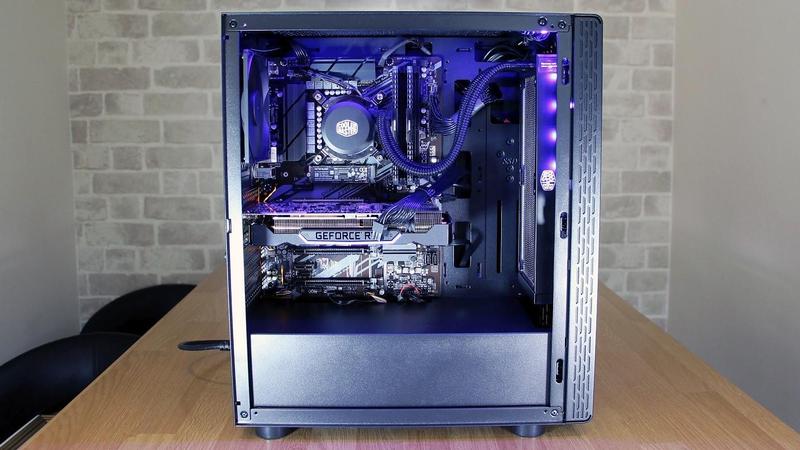PC Specialist Vulcan S2

Published on 14 Apr 2019 4 mins reading time Categories: DesktopComputers
This £1,394 machine is built around two key components: an Intel Core i7-9700 processor and an Nvidia GeForce RTX 2070 graphics card. You’ll need to buy it direct from PC Specialist.
That’s a lot of power for this price, and it squares up well against its key rival. The Overclockers Hoplite originally arrived at £1,479, but now it costs £1,299 – so it’s £100 cheaper than the PC Specialist machine. That rig relies on an AMD Ryzen 7 2700X CPU and RTX 2060 graphics.
The Vulcan S2 is protected by the standard PC Specialist deal, which is a three-year labour deal with one year of parts protection and one month of collection coverage.
Check out our best gaming PC chart. Design & Build
PC Specialist has used one of its own enclosures for this machine. It’s called the PCS P209, and it nails most of the current trends. There’s a tempered glass side panel, a magnetic dust filter on top, and a slab of metal at the front.
It looks like loads of other recent cases – including the Kolink Phalanx RGB used by the Overclockers Hoplite. That PC’s enclosure also has a tempered glass side panel and a dust filter in the roof, but its front-mounted trio of RGB LED fans are more eye-catching.
PC Specialist Vulcan S2 case
The P209 is 455mm tall and 390mm deep, so it’s smaller than the Kolink – that unit is 510mm talk and 445mm deep. That bodes well for fitting the Vulcan into smaller spaces. Build quality is impressive, too – the steel used throughout is sturdy, so we have no concerns there.
There are slim air intake vents at the front, and at the rear there’s a 120mm exhaust. Air intake is handled by two 120mm fans that are attached to the Cooler Master MasterLiquid Lite 240 processor cooler. That’s a slight concern – because it means that cool air coming in will immediately be heated. This shouldn’t be a huge problem due to the Vulcan’s mid-range components, but the Overclockers is better-equipped due to its trio of intake fans.
The top of the P209 only has two USB 2.0 ports and one USB 3.0 connection – there’s no faster USB 3.1 port. It’s the same as the Kolink case, but it’s not particularly good for fast data transfers.
On the inside the P209 remains conventional. A PSU shroud hides the Corsair power supply, and PC Specialist has done a good job of keeping cables neat – so airflow isn’t disrupted and internal access is easy. Lighting is handled by a patterned strip of RGB LEDs down the front panel and a strip of lights to illuminate the hardware inside.
However, in some areas the P209 is basic. Behind the motherboard there’s only room to add single 2.5- and 3.5in hard disks, and the hard disk option is poor – there’s no dedicated bay and no tool-free installation.
PC Specialist Vulcan S2 ports
The Hoplite’s Kolink case is better here, with pairs of 2.5- and 3.5in hard disk bays. That case also has 370mm of graphics card clearance – 50mm more than the PCS P209.
The Vulcan’s case is smart, sturdy, small and accessible, and it has RGB LEDs. But it doesn’t have the best port selection, and the slightly cheaper Overclockers has more room to grow – as well as more extravagant design. Specs & Performance
The Nvidia GeForce RTX 2070 sits in the middle of Nvidia’s latest range. It uses the Turing architecture, which means you get the latest architectural improvements – as well as ray-tracing and DLSS.
The Vulcan’s RTX 2070 is made by Palit, and it uses the GPU’s stock configuration with no overclocking. That means you get 2,304 stream processors, 8GB of memory and a boost clock of 1,620MHz.
The lack of overclocking doesn’t stop the RTX 2070 outstripping the cheaper Overclockers’ RTX 2060. The Gigabyte-made card in that machine has a small overclock, with the 1,680MHz standard turbo speed improved to 1,770MHz, but that GPU only has 1,920 stream processors and 6GB of memory.
PC Specialist Vulcan S2 Nvidia RTX 2070
Unsurprisingly, the RTX 2070 was better in our benchmarks. Its Sky Diver result of 44,637 is more than 1,000 points ahead of the Hoplite. The PC Specialist handled Total War: Warhammer 2 at 1080p and Ultra settings at 152fps – five frames ahead of the Hoplite. At Ultra the Vulcan ran at 91fps – a four-frame advantage.
In the tougher Ghost Recon: Wildlands, at 1080p and at Ultra settings, the Vulcan still blasted through with an average of 65fps – easily playable.
The Vulcan played games at 1440p, too: in Warhammer and Ghost Recon at maximum settings it averaged 62- and 51fps respectively.
The RTX 2070 can’t handle 4K, though. It only managed good framerates at Medium settings – at Ultra, in both games, minimum framerates dipped below 30fps. You’re either going to get stuttering gameplay or you’ll have to drop the quality levels, and neither is ideal.
Back to Archive